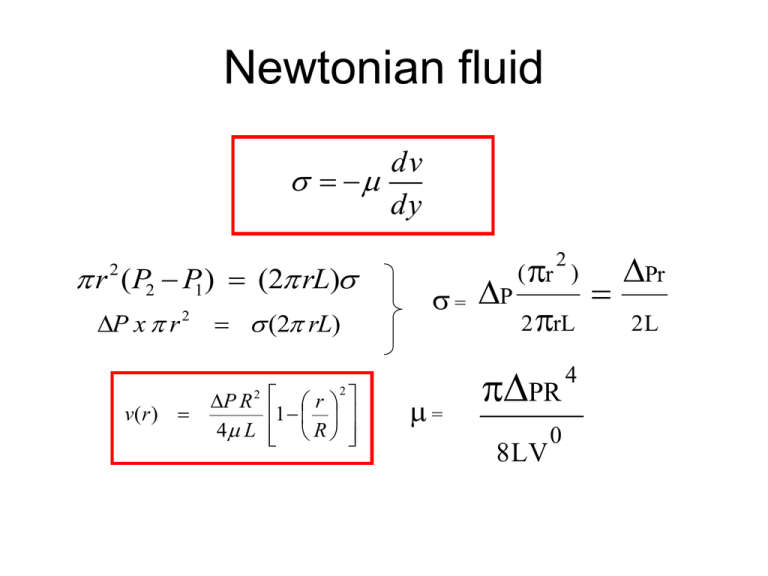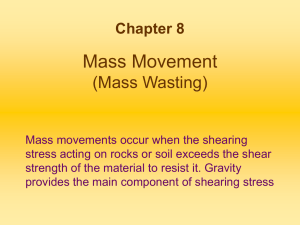Non-Newtonian Fluids
advertisement

Newtonian fluid dv dy r (P2 P1 ) (2 rL) 2 P x r 2 v(r ) (2 rL) P R 2 4 L r 2 1 R 2 ( r ) Pr = P 2 rL 2L 4 = PR 0 8 LV Definition of a Newtonian Fluid du F yx yx A dy For Newtonian behaviour (1) is proportional to and a plot passes through the origin; and (2) by definition the constant of proportionality, Newtonian dv dy r (P2 P1 ) (2 rL) 2 P x r 2 v(r ) (2 rL) P R 2 4 L r 2 1 R 2 ( r ) Pr = P 2 rL 2L 4 = PR 0 8 LV Newtonian From and (r 2 ) Pr du = P 2rL 2L dy = PR4 8LV 0 = 8v/D 8LQ P = R 4 5 6 Non-Newtonian Fluids Flow Characteristic of Non-Newtonian Fluid • Fluids in which shear stress is not directly proportional to deformation rate are non-Newtonian flow: toothpaste and Lucite paint (Casson Plastic) (Bingham Plastic) Viscosity changes with shear rate. Apparent viscosity (a or ) is always defined by the relationship between shear stress and shear rate. Model Fitting - Shear Stress vs. Shear Rate Summary of Viscosity Models t Newtonian Pseudoplastic t K Dilatant t n K Bingham t ty Casson t Herschel-Bulkley t 1 2 n ( n < 1) ( n > 1) + t 1 2 0 + n 1 1 2 2 c ty + K n t or = shear stress, º = shear rate, a or = apparent viscosity m or K or K'= consistency index, n or n'= flow behavior index Herschel-Bulkley model (Herschel and Bulkley , 1926) n du m + 0 dy Values of coefficients in Herschel-Bulkley fluid model Fluid m n 0 Herschel-Bulkley >0 0<n< >0 Minced fish paste, raisin paste Newtonian >0 1 0 Water,fruit juice, honey, milk, vegetable oil Shear-thinning (pseudoplastic) >0 0<n<1 0 Applesauce, banana puree, orange juice concentrate Shear-thickening >0 1<n< 0 Some types of honey, 40 % raw corn starch solution Bingham Plastic >0 1 >0 Toothpaste, tomato paste Typical examples Non-Newtonian Fluid Behaviour The flow curve (shear stress vs. shear rate) is either non-linear, or does pass through the origin, or both. Three classes can be distinguished. (1) Fluids for which the rate of shear at any point is determined only by the value of the shear stress at that point at that instant; these fluids are variously known as “time independent”, “purely viscous”, “inelastic”, or “Generalised Newtonian Fluids” (GNF). (2) More complex fluids for which the relation between shear stress and shear rate depends, in addition, on the duration of shearing and their kinematic history; they are called “timedependent fluids”. (3) Substances exhibiting characteristics of both ideal fluids and elastic solids and showing partial elastic recovery, after deformation; these are characterised as “visco-elastic” fluids. Time-Independent Fluid Behaviour 1. Shear thinning or pseudoplastic fluids Viscosity decrease with shear stress. Over a limited range of shearrate (or stress) log (t) vs. log (g) is approximately a straight line of negative slope. Hence tyx = m(yx)n (*) where m = fluid consistency coefficient n = flow behaviour index Re-arrange Eq. (*) to obtain an expression for apparent viscosity app (= tyx/yx) Pseudoplastics Flow of pseudoplastics is consistent with the random coil model of polymer solutions and melts. At low stress, flow occurs by random coils moving past each other w/o coil deformation. At moderate stress, the coils are deformed and slip past each other more easily. At high stress, the coils are distorted as much as possible and offer low resistance to flow. Entanglements between chains and the reptation model also are consistent with the observed viscosity changes. Why Shear Thinning occurs Sheared Unsheared Anisotropic Particles align with the Flow Streamlines Random coil Polymers elongate and break Aggregates break up Courtesy: TA Instruments 2. Viscoplastic Fluid Behaviour Viscoplastic fluids behave as if they have a yield stress (t0). Until t0 is exceeded they do not appear to flow. A Bingham plastic fluid has a constant plastic viscosity t yx t 0B + B yx for t yx > t 0B yx 0 for t yx < t 0B Often the two model parameters t0B and B are treated as curve fitting constants, even when there is no true yield stress. 3. Shear-thickening or Dilatant Fluid Behaviour Eq. (*) is applicable with n>1. Viscosity increases with shear stress. Dilatant: shear thickening fluids that contain suspended solids. Solids can become close packed under shear. Source: Faith A. Morrison, Michigan Tech U. Source: Faith A. Morrison, Michigan Tech U. Source: Faith A. Morrison, Michigan Tech U. Time-dependent Fluid Behaviour The response time of the material may be longer than response time of the measurement system, so the viscosity will change with time. Apparent viscosity depends not only on the rate of shear but on the “time for which fluid has been subject to shearing”. Thixotropic : Material structure breaks down as shearing action continues : e.g. gelatin, cream, shortening, salad dressing. Rheopectic : Structure build up as shearing continues (not common in food : e.g. highly concentrated starch solution over long periods of time Thixotropic Shear stress Rheopectic Shear rate Time independent Time dependent _ + A B C D _ + E F G Non - newtonian Rheological curves of Time - Independent and Time – Dependent Liquids Visco-elastic Fluid Behaviour A visco-elastic fluid displays both elastic and viscous properties. A true visco-elastic fluid gives time dependent behaviour. Pseoudoplastic Dilatant Shear stress Shear stress Newtonian Shear rate Shear rate Shear rate Viscosity Viscosity Viscosity Shear rate Shear rate Common flow behaviours Shear rate Examples Newtonian flow occurs for simple fluids, such as water, petrol, and vegetable oil. The Non-Newtonian flow behaviour of many microstructured products can offer real advantages. For example, paint should be easy to spread, so it should have a low apparent viscosity at the high shear caused by the paintbrush. At the same time, the paint should stick to the wall after its brushed on, so it should have a high apparent viscosity after it is applied. Many cleaning fluids and furniture waxes should have similar properties. Examples The causes of Non-Newtonian flow depend on the colloid chemistry of the particular product. In the case of water-based latex paint, the shear-thinning is the result of the breakage of hydrogen bonds between the surfactants used to stabilise the latex. For many cleaners, the shear thinning behaviour results from disruptions of liquid crystals formed within the products. It is the forces produced by these chemistries that are responsible for the unusual and attractive properties of these microstructured products. Newtonian Foods Shear stress Shear rate Examples: • Water • Milk • Vegetable oils • Fruit juices • Sugar and salt solutions Pseudoplastic (Shear thinning) Foods Shear stress Shear rate Examples: • Applesauce • Banana puree • Orange juice concentrate • Oyster sauce • CMC solution Dilatant (Shear thickening) Foods Shear stress Shear rate Examples: • Liquid Chocolate • 40% Corn starch solution Bingham Plastic Foods Shear stress Shear rate Examples: • Tooth paste • Tomato paste Non-Newtonian Fluids Newtonian Fluid du z t rz dr Non-Newtonian Fluid du z t rz dr η is the apparent viscosity and is not constant for non-Newtonian fluids. η - Apparent Viscosity The shear rate dependence of η categorizes non-Newtonian fluids into several types. Power Law Fluids: Pseudoplastic – η (viscosity) decreases as shear rate increases (shear rate thinning) Dilatant – η (viscosity) increases as shear rate increases (shear rate thickening) Bingham Plastics: η depends on a critical shear stress (t0) and then becomes constant Modeling Power Law Fluids Oswald - de Waele n 1 duz duz duz t rz K K dr dr dr n where: K = flow consistency index n = flow behavior index eff Note: Most non-Newtonian fluids are pseudoplastic n<1. Modeling Bingham Plastics Yield stress du z t rz t 0 dr t rz t 0 Frictional Losses Non-Newtonian Fluids Recall: 2 LV hf 2 f D g Applies to any type of fluid under any flow conditions Power Law Fluid duz t rz K dr n duz 1 p 1 n r dr 2 KL 1n Boundary Condition rR uz 0 Velocity Profile of Power Law Fluid Circular Conduit Upon Integration and Applying Boundary Condition We can derive the expression for u(r) 1 p n uz R 2 KL n + 1 1n n +1 n r n +1 n Power Law Results (Laminar Flow) 3n + 1 n LKV n n +1 D n 2 p ↑ n+2 Hagen-Poiseuille (laminar Flow) for Power Law Fluid Recall 1 D 2 p f 2 4 L V ↑ Laminar Friction Factor Power Law Fluid 16 f RePL n +1 3n + 1 2 K n f 2n n V D n Define a Power Law Reynolds Number or Generalized Reynolds number (GRe) n V D K 3n + 1 n 3 n RePL 2 2n n Turbulent Flow flow behavior index Power Law Fluid Example A coal slurry is to be transported by horizontal pipeline. It has been determined that the slurry may be described by the power law model with a flow index of 0.4, an apparent viscosity of 50 cP at a shear rate of 100 /s, and a density of 90 lb/ft3. What horsepower would be required to pump the slurry at a rate of 900 GPM through an 8 in. Schedule 40 pipe that is 50 miles long ? P = 1atm P = 1atm L = 50 miles V V K ' app r r n' 1 0.4 100 K ' 50cP s 0.792 kg m s1.6 m 1 m 900gal 1 ft 3 1 min V 1.759 s min 7.48gal 60s 0.3474ft 2 3.281ft ~ 1.6 kg m 0.4 0.4 0.202 m 1442 1.759 3 0.4 m s REN 230.4 7273 kg 3 (0.4) + 1 0 . 792 1.6 m s V 2 gZ Wp + + + hf 2gc gc P 2 L V Wp h f 4 f D 2 f 0.0048 Fig 5.11 2 m 1 . 760 m2 s 80460m W p h f 40.0048 11,845 2 0 . 202 m 2 s m 1.759 m kg kg 0.0323m 2 1442 3 81.9 s m s kg m2 81.9 11,845 2 s s Power 970.1 kW 1300 Hp 1000 Bingham Plastics Bingham plastics exhibit Newtonian behavior after the shear stress exceeds to. For flow in circular conduits Bingham plastics behave in an interesting fashion. Sheared Annular Region Unsheared Core Bingham Plastics Unsheared Core r rc t0 2 R rc u z uc 2 rc Sheared Annular Region r > rc uz R r t rz r 1+ t 2 R 0 Laminar Bingham Plastic Flow 16 f Re BP He He He4 3 1 + 7 6 Re BP 3 f Re BP D t 0 Re BP (Non-linear) 2 2 DV Hedstrom Number Turbulent Bingham Plastic Flow f 10 Re a 0.193 BP a 1.3781 + 0.146e 2.9 x10 5 He Bingham Plastic Example Drilling mud has to be pumped down into an oil well that is 8000 ft deep. The mud is to be pumped at a rate of 50 GPM to the bottom of the well and back to the surface through a pipe having an effective diameter of 4 in. The pressure at the bottom of the well is 4500 psi. What pump head is required to do this ? The drilling mud has the properties of a Bingham plastic with a yield stress of 100 dyn/cm2, a limiting (plastic) viscosity of 35 cP, and a density of 1.2 g/cm3. P = 14.7 psi L = 8000 ft P = 4500 psi D 4 ft 0.3333 ft 12 Area 0.0873 ft 2 gal min ft 3 1 V 50 min 60s 7.48gal 0.0873ft 2 1.2 62.4 ft 1.276 s lbm lbm 74 . 88 ft 3 ft 3 lb 6.7197 10 4 m lb ft s 35 cP 0.0235 m cP ft s N RE lb ft 0.3333ft 1.276 74.88 m s ft 3 1355 lbm 0.0235 ft s t o 100 dyn g 100 cm2 s 2 cm 2 N HE g 100g 2.54 cm 4in 1.2 3 2 in cm s cm 5 1 . 01 10 2 g 0.35 cm s f 0.14 V 2 gZ Wp + + + hf 2gc gc P 2 lb f 144 in 2 ft 4500 14.7 2 2 1 . 276 ft lb f 4 0.14 8000ft in ft s Wp 8000 + lbm lbm 0.3333ft 32.2 ft lbm 74.88 3 2 lb s 2 ft f Wp 8626 8000+ 339 965 ft lb f lbm Viscometers In order to get meaningful (universal) values for the viscosity, we need to use geometries that give the viscosity as a scalar invariant of the shear stress or shear rate. Generalized Newtonian models are good for these steady flows: tubular, axial annular, tangential annular, helical annular, parallel plates, rotating disks and cone-and-plate flows. Capillary, Couette and cone-andplate viscometers are common. Non-newtonian fluid • from = 2r2L = dω r dr n Ω - μ rdω dr 2 2Lr Integrate from r = Ro Ri and = 0i Non-newtonian fluid or a º • obtain t 4N - K n n -K.n n 4N n 14N n 1 n 4N - K.n ln ln K - n ln n + (n -1) ln 4N Linear : y = y-intercept + slope (x) K and n 4 y = -0.7466x + 3.053 3.5 2 R = 0.9985 3 n = 1.7466 ln Ua 2.5 2 1.5 K = 56.09 1 0.5 0 -1 -0.5 0 0.5 ln 4TTN 1 1.5 2 (shear thinning)







